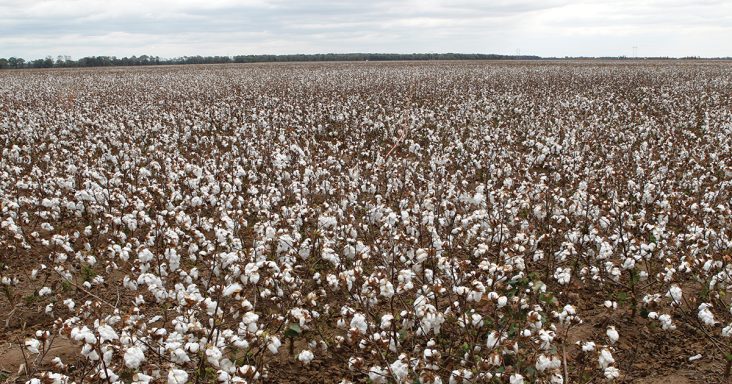Major crops on pace for high yields; peanut acres set new record
by December 4, 2024 1:00 pm 289 views

Corn, soybeans, squash and other crops have been grown in the Arkansas Delta for at least a thousand years and yield numbers for some of those row crops could set all-time records once the harvest is complete this year.
Soybeans are on pace for a record state average yield. Corn and rice will both have their second-best yield numbers ever, according to the Crop Production report from the U.S. Department of Agriculture’s (USDA) National Agricultural Statistics Service (NASS) released in November.
“It’s the last month this calendar year that NASS will make any production adjustments,” said Scott Stiles, extension economics program associate for the University of Arkansas System Division of Agriculture. “Final 2024 production figures for grains and soybeans will be released in January with cotton coming in May.”
There had been some speculation that yields for soybeans and cotton might decline slightly due to damage from the remnants from hurricanes Francine and Helene that impacted the state in early fall. A rapid harvest minimized impacts from the storms, Stiles said.
“By the end of September, corn was 95% harvested, so it was largely spared from the additional rains that Helene brought us,” he said. “Rice was 85% harvested at that time. Soybeans were 47% harvested and cotton just 21%, so there were some adverse quality impacts from the rains we received from Francine and Helene.”
Arkansas producers harvested 640,000 corn acres, with an expected yield of 186 bushels per acre.
“Overall, it was a really good year for corn,” said Jason Kelley, extension wheat and feed grains agronomist for the Division of Agriculture. “At 186 bushels per acre state average, that’s just one bushel per acre less than the record in 2014.”
Kelley said Northeast Arkansas seemed to have the highest yields, which was “not unexpected since they were able to get planted very early this year and missed the heavy rains that other parts of the state experienced at planting.”
“Timely rains this summer helped reduce irrigation needs and helped maintain our yields,” he said. “Fortunately, most of the corn was harvested before tropical storm Helene came through.”
NASS in August projected Arkansas to have a state average of 57 bushels per acre over 3.02 million harvested acres. Stiles said “soybean yield was dialed down two bushels in September to 55 bushels per acre, which is still a record.”
“Looks like we’re going to have another record year,” said Jeremy Ross, extension soybean agronomist for the Division of Agriculture. “There were some quality issues after the two hurricanes came through, but I think it was isolated.”
Ross said the ones who did get hit by Francine and Helene got hit hard.
“It hurt them. But you know it was just a fraction of the production,” he said.
Ross said the quality issues for soybean growers centered on mold and mildew that hit “the beans that should have been harvested prior to Francine. Then it rained for five days with high temperatures and high humidity. Then it was another week before farmers could get into the fields to get those knocked out.”
NASS projects rice to end the season at 7,600 pounds per acre, 30 pounds shy of the record set in 2021.
“There are still no surprises on the rice side,” said Jarrod Hardke, extension rice agronomist for the Division of Agriculture. “I was expecting the yield to stay very close to the previous record of 7,630 pounds per acre, and possibly exceed by the time final numbers are released in January.”
Hardke said that, “unfortunately, milling yields aren’t represented in production estimates but will have a profound impact on rice supplies and markets this year.”
“Reduced whole kernels from grains breaking in the milling process lowers the value of the rice, which can affect grower price and the ability to meet market demand,” he said.
There were 485,000 cotton acres harvested with a yield of 1,200 pounds of lint per acre. That’s down from its September estimate of 1,238 pounds of lint per acre. The current record of 1,295 pounds per acre was set last year.
Was damage from Francine and Helene an issue?
“I think that’s a fair assumption on the cotton revision,” said Zachary Treadway, extension cotton and peanut agronomist for the Division of Agriculture. “While we fared better than we might have expected, there was inevitably going to be some yield decrease. I am still hearing from producers and consultants that are making very impressive yields.”
“With more favorable weather in October, sample grades for cotton did show improvement throughout October, Stiles said. “But, the September rain did cost growers close to $25 per acre in lower color grades and higher leaf content.”
Arkansas was expected to yield 5,300 pounds of peanuts per acre, an estimate unchanged since August. The record for peanut yield in Arkansas is 5,800 pounds set last year. The 44,000 acres of peanuts in Arkansas is a new record, besting the previous record of 41,000 set in 1943.
“As for peanuts, that final number will be worth watching, as we are seeing some untimely rains, and producers are having a hard time getting trailers in the field in some instances,” Treadway said. “Those two factors combine to force peanuts to lay on the ground longer than is optimal, and we could see yield loss as a result.”
